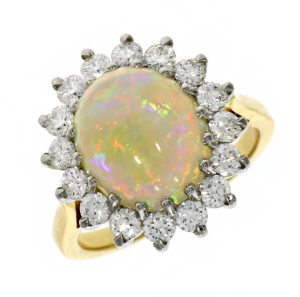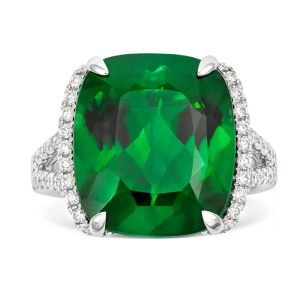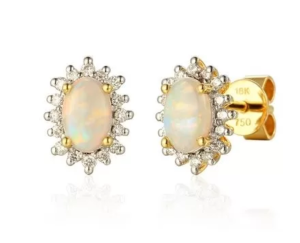The opal and the tourmaline make up the two birthstones for the month of October. Both gems are equally beautiful and elegant, with the tourmaline being available in a rainbow of gorgeous colours, and the opal possessing unique colour combinations.
Their stunning appearance makes them popular and widely used in jewellery. They’re also rich in symbolism and have been attributed to divinity and royalty over the years. With these and more wonderful properties, October’s birthstones can suit a wide range of personal tastes.
PROPERTIES OF THE OPAL
This gorgeous October birthstone is sought-after for its fantastic properties, such as:
Colour – Opals diffract light to show a beautiful array of colours; the ‘ideal opal’ displays wide patterns on the surface with all colours of the rainbow, including red. Because of this diffraction, opals can take on a unique range of colours. Some hues are more common, such as the white and green, while black is the rarest.
Hardness – Opals range between 5.5 to 6 on the Mohs scale of hardness, making it a delicate stone that can crack under extreme temperature or light.
Shape – This gemstone comes in many different shapes, with the rarest type being the ‘pipe’ opal, which forms in sandstone and possesses some iron-ore content.
Image: 18ct Yellow Gold 3.42ct Opal and Diamond Cluster Ring
HISTORY OF THE TOURMALINE
The name ‘tourmaline’ is believed to have been derived from the Sinhalese words ‘tura mali’, which means ‘stone of mixed colours’. This gemstone stands apart from others because it’s not one mineral, but a complex group of minerals with different chemical compositions and properties.
it’s not one mineral, but a complex group of minerals with different chemical compositions and properties.
Today, deposits of tourmaline can be found all over the world, from Australia and Nepal to Russia, Sri Lanka and the United States. Nevertheless, fine bright-coloured gem-quality tourmaline is rare to find, and the price of these stones is usually tied to their hues.
Ancient Egyptians believed that this stone passed through a rainbow and the earth until it reached the surface of the planet, which was the cause of its beautiful colours. However, even though this gem has left traces throughout history, the earliest records regarding the discovery of tourmaline point to the 16th century in Brazil.
A Spanish conquistador uncovered a green tourmaline gem that he initially mistook for an emerald. This misunderstanding continued until the 1800s when the stone was finally recognised as tourmaline. The Dutch brought Sri Lankan tourmaline to Europe for many centuries as well, until it was discovered that the stone was the same as school.
Tourmaline was incredibly important in China, as the country was also the biggest market for the stone. The Chinese Empress Dowager Tz’u Hsi was fond of pink tourmalines and often purchased them from deposits in California. When the government collapsed in 1912, trade of this gemstone was affected worldwide.
Image: 18ct White Gold 10.91ct Green Tourmaline and Diamond Cocktail Ring
FAMOUS OPALS AROUND THE WORLD
Like other gemstones, opals vary in regard to quality and value. Some have achieved enough popularity to be part of the list of the most precious jewels around the globe:
- Olympic Australis – This is the world’s largest and most valuable opal; it was uncovered in Coober Pedy in Australia, during the Olympic Games in Melbourne in 1956. This gem measures 11 inches in length, weighs 17,000 carats (7.6 pounds) and was valued at around £1.9 million in 2005.
- Haley’s Comet Opal – According to Guinness World Records, this gem is the world’s biggest uncut black opal and was named after the Haley’s Comet, which could be seen from Earth in the same year the opal was found, 1986. It was unearthed in New South Wales, in the Lightning Ridge and is nearly flawless at 1,982.5 carats (396.50g).
- Andamooka Opal – Discovered in Andamooka, an opal mining town in South Australia, this gem was cut, polished and set into a palladium necklet which was given as a gift to Queen Elizabeth II upon her first visit to South Australia in 1954
FAMOUS TOURMALINES AROUND THE WORLD
 Tourmaline is popular for its stunning, colourful shades that create beautiful jewellery. They can easily complement any wardrobe as well, making them one of the most versatile gems. Some of the most famous tourmalines include.
Tourmaline is popular for its stunning, colourful shades that create beautiful jewellery. They can easily complement any wardrobe as well, making them one of the most versatile gems. Some of the most famous tourmalines include.
- Ethereal Carolina Divine Paraíba – This flawless oval-shaped Paraíba tourmaline necklace weighs 191.87 carats and was included in the Guinness World Records as the largest cut tourmaline. Its colour derives from its copper content, and its value is estimated to be between £19 million and £95 million.
- Jolly Green Giant – This stone is displayed in the Smithsonian and was found in 1972 in Newry, Maine. Measuring over 10 inches tall, this tourmaline is one of the largest terminated elbaite crystals ever discovered in North America. It possesses a pink inner core covered by a thin green layer, which indicates a change in chemical composition.
- Elbaite Gem – Also found in Newry, Maine, this tourmaline is a round brilliant stone that weighs 48.77 carats and possesses a vivid bluish-green colour. This gem is also on display in the Smithsonian.
Image: 18ct Yellow & White Gold 0.53ct Opal And Diamond Cluster Earrings
OPAL AND TOURMALINE AT BANKS LYON
October appears to be the most vibrant month with such colourful gemstones as the opal and the tourmaline. At Banks Lyon, we offer a lovely range of October birthstones, ideal for the contemporary woman who loves to finish a wardrobe with a touch of luxury, sophistication and colour. These gems also make fantastic anniversary gifts; opal is often given to celebrate a 14th wedding anniversary, whereas tourmaline commemorates a 38th anniversary. With their rainbow of colours, opal and tourmaline are unique, individual gems that perfectly match the wearer’s personality.
Visit us in Lancaster and Kendal to view our beautiful birthstone jewellery, and we will be more than happy to help you find a piece that you will cherish for years to come.